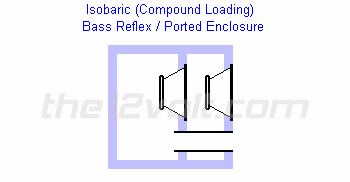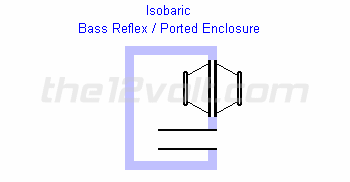Hi all,
Anyone know the voice coil phase alignment of the mid/high frequency unit with the isobaric woofer? Align with the front or the rear unit?


Somebody claim the isobaric design make the output double(3db gain) but I find a website said:
" The volume of the enclosure wil be approximately half the space of the above enclosure with the same results, and the output will be the same."
Is it right?
Rgs
Jimmy
Anyone know the voice coil phase alignment of the mid/high frequency unit with the isobaric woofer? Align with the front or the rear unit?


Somebody claim the isobaric design make the output double(3db gain) but I find a website said:
" The volume of the enclosure wil be approximately half the space of the above enclosure with the same results, and the output will be the same."
Is it right?
Rgs
Jimmy
The output is a combination of the two units so at bass frequencies I would think the acoustic centre is half way between the two voice coils. At higher frequencies I think the coupling between the drivers would fall apart so I think the front driver would dominate.
If you have two 8 ohm drivers in parallel, you have 4 ohms so your amp should be pumping 3dB more into them for the same volume control setting.
Jimmy DIY said:Somebody claim the isobaric design make the output double(3db gain) but I find a website said:
" The volume of the enclosure wil be approximately half the space of the above enclosure with the same results, and the output will be the same."
Is it right?
If you have two 8 ohm drivers in parallel, you have 4 ohms so your amp should be pumping 3dB more into them for the same volume control setting.
Re: Re: Phase alignment of the isobaric design
I agree with that. The front cone will be the one emitting sound as the rear one serves to simply make the front cone seem like it's twice as heavy. The acoustic centre is also NOT the magnet which is so commonly misthought. It is where the sound radiates from, which is usually just down by the area around the dust cap.
Again I agree. The SPL will be the same but the power requirements double, which is the price you pay for half the box size.
lndm said:The output is a combination of the two units so at bass frequencies I would think the acoustic centre is half way between the two voice coils. At higher frequencies I think the coupling between the drivers would fall apart so I think the front driver would dominate.
I agree with that. The front cone will be the one emitting sound as the rear one serves to simply make the front cone seem like it's twice as heavy. The acoustic centre is also NOT the magnet which is so commonly misthought. It is where the sound radiates from, which is usually just down by the area around the dust cap.
lndm said:If you have two 8 ohm drivers in parallel, you have 4 ohms so your amp should be pumping 3dB more into them for the same volume control setting.
Again I agree. The SPL will be the same but the power requirements double, which is the price you pay for half the box size.
Isobaric configuration is mostly a waste of resources. It draws double the amplifier power and produces the same output as a single driver.
If you have two drivers, use them together both radiating, this will also draw double the amplifier power but will produce 6dB more output than a single driver or a isobaric system.
If you have two drivers, use them together both radiating, this will also draw double the amplifier power but will produce 6dB more output than a single driver or a isobaric system.
Eva said:Isobaric configuration is mostly a waste of resources. It draws double the amplifier power and produces the same output as a single driver.
If you have two drivers, use them together both radiating, this will also draw double the amplifier power but will produce 6dB more output than a single driver or a isobaric system.
The engineering choice isn't that simple. With high Vas drivers, the isobaric can usefully allow significant size reduction.
Acoustic center for crossover to the midrange needs to be determined experimentally on a case by case basis. Rules of thumb almost never are accurate enough to prevent severe crossover problems.
One nice trick is to add a choke in series with the inner driver.
SY said:
The engineering choice isn't that simple. With high Vas drivers, the isobaric can usefully allow significant size reduction.
Acoustic center for crossover to the midrange needs to be determined experimentally on a case by case basis. Rules of thumb almost never are accurate enough to prevent severe crossover problems.
One nice trick is to add a choke in series with the inner driver.
It's seem the claim of isobaric design has double output is not true, but as SY said it's worth to apply for significant size reduction in high Vas drivers.
About the phase alignment, how to measure it accurately if Rules of thumb can't help? Are there any reference or books for the diyer? Is the "Loudspeaker design cook book" has the solution? The "Speaker Workshop" freeware can hlep or not?
And what is the purpose to add a choke in series with the inner driver? How to practical it?
Rgs
Jimmy
Jimmy DIY said:Somebody claim the isobaric design make the output double(3db gain) but I find a website said:
" The volume of the enclosure wil be approximately half the space of the above enclosure with the same results, and the output will be the same."
Is it right?
Rgs
Jimmy
With two identical drivers, in terms of *voltage sensitivity* (dBSPL/V) this is correct. Voltage sensitivity will stay unchanged. But since the second driver will halve the overall impedance and thus both drivers now draw double the current for a given voltage (and SPL). the *power sensitivity* changes accordingly.
You may now go ahead and do the "power efficiency calculus" (dBSPL@1W/1m) by impedance over frequency...

regards
Hi,
if its not yet obvious you should not use an isobaric configuration
up to frequencies where phase alignment or acoustic centres are
an issue. You will get severe cancellation at certain frequencies.
One way of avoiding this is the series inductor for the rear unit.
However the small coupling space between drivers is not good
for preventing rereflection through the front cone, but can work.
 /sreten.
/sreten.
if its not yet obvious you should not use an isobaric configuration
up to frequencies where phase alignment or acoustic centres are
an issue. You will get severe cancellation at certain frequencies.
One way of avoiding this is the series inductor for the rear unit.
However the small coupling space between drivers is not good
for preventing rereflection through the front cone, but can work.
How about this kind of Isobaric configuration:



I have just read the David B. Weems's book, he said the out of phase push-pull combination operation can cancels distortion, half the space of the enclosure size.
But I find it is both drivers align outside the baffle, is it double the output against the inner-outer style Isobaric configuration?
Rgs
Jimmy



I have just read the David B. Weems's book, he said the out of phase push-pull combination operation can cancels distortion, half the space of the enclosure size.
But I find it is both drivers align outside the baffle, is it double the output against the inner-outer style Isobaric configuration?
Rgs
Jimmy
The driver configiguration of one facing in one facing out is not isobaric as SY says but it does minimise 2nd harmonic distortion. This is due to the voice coil inductance decreasing when the voice coil moves out of the magnet and conversly the inductance increases when it moves into the magnet. So that config tends to cancel that effect. It only works at low frequencies though.
I think I make a mistake,  the author put different figures in the same place without clarification, in fact they don't work in in the same way, and yes if they connected in the same phase, it will cause cancellation effect to the sound wave, they jusy apply to cancels 2nd harmonic distortion but not to reduce the size of the enclosure because they connected in the reverse phase.
the author put different figures in the same place without clarification, in fact they don't work in in the same way, and yes if they connected in the same phase, it will cause cancellation effect to the sound wave, they jusy apply to cancels 2nd harmonic distortion but not to reduce the size of the enclosure because they connected in the reverse phase.
 the author put different figures in the same place without clarification, in fact they don't work in in the same way, and yes if they connected in the same phase, it will cause cancellation effect to the sound wave, they jusy apply to cancels 2nd harmonic distortion but not to reduce the size of the enclosure because they connected in the reverse phase.
the author put different figures in the same place without clarification, in fact they don't work in in the same way, and yes if they connected in the same phase, it will cause cancellation effect to the sound wave, they jusy apply to cancels 2nd harmonic distortion but not to reduce the size of the enclosure because they connected in the reverse phase.Yupp. The last pics are not isobaric.
Back to isobaric:
Sreten and SY already pointed out some drawbacks of isobaric.
I used it in order to reduce size. In first simplyfied approach you can guess that two isobaric drivers will act like one speaker with about half of the VAS, half electrical impedance and 3db less db/W. Please note db/V remain the same.
I used it with some cheapy no spec 20cm drivers.
It was working great, except some additional resonances at 1 kHz and above! So this is another reason not to use it at frequencies, where we would have to think about phase alignment.
The undesired frequencies may depend on the geomtery of the isobaric coupling. Mounting directly face to face gave the best results in my experiments.
Back to isobaric:
Sreten and SY already pointed out some drawbacks of isobaric.
I used it in order to reduce size. In first simplyfied approach you can guess that two isobaric drivers will act like one speaker with about half of the VAS, half electrical impedance and 3db less db/W. Please note db/V remain the same.
I used it with some cheapy no spec 20cm drivers.
It was working great, except some additional resonances at 1 kHz and above! So this is another reason not to use it at frequencies, where we would have to think about phase alignment.
The undesired frequencies may depend on the geomtery of the isobaric coupling. Mounting directly face to face gave the best results in my experiments.
- Status
- This old topic is closed. If you want to reopen this topic, contact a moderator using the "Report Post" button.
- Home
- Loudspeakers
- Multi-Way
- Phase alignment of the isobaric design